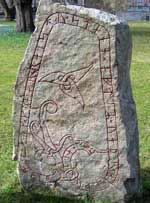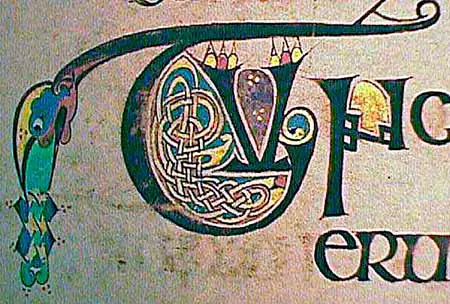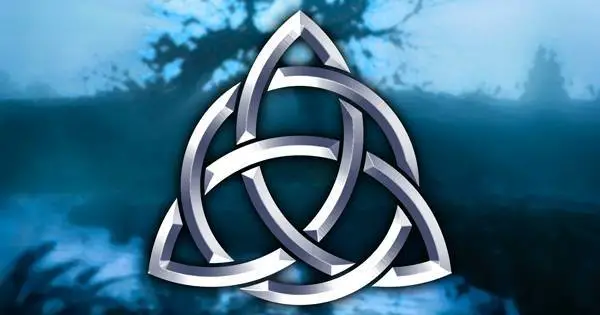The Triquetra, also known as the Trinity Knot, is an ancient Celtic symbol that was later taken and absorbed into the Christian tradition. It soon became one of the signature designs in Celtic jewelry and remains popular today, even among people with no Celtic or religious affinity.
It has deep historic and cultural significance for people in Ireland but it has also transcended borders. It is recognised across the world for it rich and varied symbolism.
The story of the triquetra can be traced back to ancient times. It has been found in Celtic artefacts from the 7th century AD, where it was incorporated into intricate knotwork designs
It’s fascinating to examine how this simple design has been interpreted in so many different ways throughout history and in so many different cultures.
History and meaning of the Triquetra
The trinity knot gained prominence during the early Christian era, as it was used to represent the Holy Trinity of Father, Son, and Holy Spirit. It also features prominently in Norse mythology. It was associated with the three goddesses of fate, the Norns, the female beings who govern fate and destiny..
Like all Celtic knots, the triquetra is constructed of one continuous line interweaving around itself, symbolising no beginning or end, an eternal spiritual life.
The Celts favoured the idea that everything important in the world came in threes. There were the three stages of life; childhood, adulthood and old age. Ancient people also thought of it as the three domains; earth, sea and sky. There was also the concept of past, present and future; reminding us of the cyclical nature of life and the importance of learning from the past and embracing the future.
With all these concepts in mind, the triquetra is sometimes drawn weaving around a circle, symbolising the unity of the three parts.
The Christians adopted this knot because it fitted in so well with their belief system, built around the concept of the Holy Trinity. This led to the triquetra’s alternative name of the trinity knot.

It also closely resembles three interlocking fish, the fish being an ancient Christian symbol which predates the crucifix by hundreds of years.
Variations of this symbol have been found around the globe. Pictures of interlocking fish can be found on Egyptian and Roman artefacts, and Scandinavian runestones have been found displaying the three-cornered geometric shape.
The knot in pagan and Wiccan traditions
The triquetra is also highly significant in pagan and Wiccan traditions, where it is often associated with women and fertility.
It was often used to represent various forms of the Triple Goddess, embodying the three phases of a woman’s life: maiden, mother, and crone. The word crone became a derogatory term in the Middle Ages, suggesting barrenness but in earlier times it had no negative connotations and was merely a word for a woman in old age. In this tradition, the triquetra symbolizes the cycle of birth, life, and death, and the eternal nature of the feminine energy in the universe.
Alternative pagan and Wiccan traditions also thought of the symbol as representing the harmony and balance between the mind, body, and spirit. The three loops signify these interconnected aspects of human existence, emphasizing the importance of maintaining equilibrium and wholeness in one’s life.
Another interpretation involved looking at the trinity knot in a different way and seeing the interlocking loops of the Triquetra as signifying the concept of protection and unity. It was believed to ward off negative energies, symbolizing an unbreakable shield against harm. The symbol’s interwoven nature also represents the interconnection and interdependence of all things, promoting a sense of unity and harmony.

Trinity knots in Christian artwork
Although it is thought that this symbol was around before Christianity, The triquetra and similar Celtic knots were prevalent in Christian artwork all over Britain and Ireland.
Intricate Celtic knots can be found on stone monuments and throughout the beautiful illuminated manuscripts created by the Celtic monks.
They are used purely as decoration and any meanings surrounding them have most likely been made up over the years.

Modern interpretations of Celtic Knots
The triquetra has retained its widespread popularity right up to the present day. It has been embraced by various communities and belief systems beyond its traditional Celtic and Christian associations.
Neopagans have adopted it and interpreted it in different ways, including as a symbol of the Triple Goddess and the three stages of womanhood: maiden, mother, crone.
The knot’s distinct shape and versatile symbolism have made it a popular choice for Celtic jewellery, and decorative items. The Triquetra has also been incorporated into popular culture, appearing in movies, books, and TV shows, often representing themes of magic, mysticism, and interconnectedness.
The symbol is also used in the Hit TV show Charmed where it represents the power of three.
Celtic knots in modern art and tattoo designs
Today the triquetra is a popular symbol to be used in tattoos, often by people with no religious or cultural connection but just like the timeless design. Several artists have spotted the potential and now offer a variety of Celtic knot designs, tailored specifically for men or women.
This has led to a whole new generation of people exploring the symbol’s meaning.
The triquetra continues to intrigue us today and its popularity shows no sign of waning. It may be that, in a modern world dominated by technology and instant but superficial artwork created by AI, the authenticity of a design created by hand thousands of years ago reaches out to something deep inside us. There is something about the search for unity, completeness and a simpler life that grips us at a very deep level.
FAQs about the Triquetra
The triquetra has been a continuous source of fascination from ancient times up to the current day. This is partly due to its intricate design but also the deep symbolism that can be interpreted in so many ways.
The triquetra is a symbol that consists of three interlocked or overlapping loops, often referred to as a “three-cornered knot” or a “Celtic triangle.” It is one of the most widely recognized Celtic symbols and has been used in various contexts throughout history.
The triquetra has multiple meanings to different cultures such as Celtic, Christian, Norse, pagan and Wicca, In Christianity, it can symbolise the Holy Trinity of Father, Son, and Holy Spirit. Additionally, the triquetra is associated with eternity, unity, and the threefold nature of existence. Its meaning can vary based on personal interpretation and belief systems.
The exact origin of the triquetra is uncertain, but it is commonly associated with Celtic art and symbolism. It has been found on Celtic stone carvings, jewellery, and illuminated manuscripts such as the Book of Kells. It is believed to have been used by the Celts as early as the 5th century.
The Triquetra symbol is primarily used as a decorative element in a variety of ways, such as jewellery, artwork, tattoos, and carvings. The symbol’s simple beauty and symbolic significance make it popular for personal expression and as a visual representation of spiritual beliefs.
The age of the Triquetra symbol is difficult to determine due to its ancient origins. Designs of interlocking loops or arcs, similar to the Triquetra, can be traced back to ancient civilizations, around the 4th century BC. However, the specific use and meaning associated with the Triquetra in Celtic and Norse cultures can be traced back to at least the 5th century BCE.
While the Triquetra is not seen as a universal symbol of hope, in some ways, it can be associated with the idea of unity, balance, and the eternal nature of existence, which can be viewed as hopeful concepts.
The Triquetra is also known as the Irish Trinity symbol or the Celtic Trinity Knot. It represents the concept of the Holy Trinity in Christianity—Father, Son, and Holy Spirit. It is associated with Irish culture, heritage, and spirituality.
The Triquetra symbol has both Norse and Celtic origins. In Norse culture, it is associated with the god Odin and symbolises the connection between the realms of life, death, and the divine. In Celtic culture, the Triquetra is tied to various meanings, such as the cycle of life, and the unity of mind, body, and spirit.
The Celtic love knot, also known as the Celtic love knot heart, is a modern decorative symbol representing eternal love and connection. It often incorporates the triquetra or similar designs and symbolises the eternal nature of love. It is used in Celtic jewellery and art as a symbol of enduring affection and devotion.
The triquetra symbol doesn’t have a good or bad meaning by itself. It can mean different things to different people, depending on their beliefs and culture. Just like any symbol, its significance and how people see it can change based on their personal beliefs and values.
It is a variation of the triquetra symbol with an added circle connecting the three interwoven loops and goes by the same name. This circular shape is thought to represent unity, eternity, and the endless cycle of life.
Trinity knot or triquetra – popular design in Celtic jewelry
